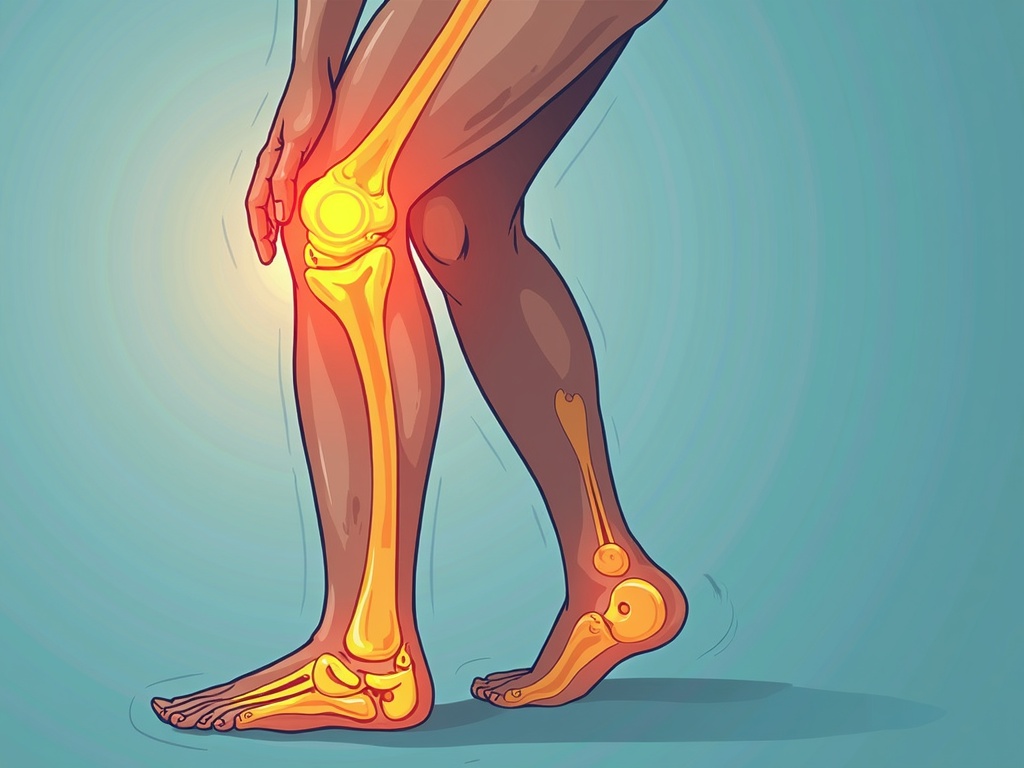The Best Exercises for Arthritis in Knees: A Comprehensive Guide
That grinding, aching feeling in your knees can make even simple activities feel like monumental tasks. If you're one of the millions suffering from arthritis in the knees, you know this all too well. But before you resign yourself to a life of limited mobility, understand this: exercise can be a powerful antidote. The right exercises can strengthen the muscles around your knee, providing support and stability, reducing pain, and improving your range of motion. This isn't about grueling workouts; it's about targeted movements that nurture your joints and help you reclaim your life.
Understanding Arthritis and its Impact on Knees
Arthritis isn't a single disease, but rather an umbrella term for joint pain and disease. Osteoarthritis, often called “wear-and-tear” arthritis, is the most common type affecting the knees. It occurs when the cartilage cushioning the bones of your knee joint gradually breaks down. Rheumatoid arthritis, an autoimmune disease, can also affect the knees, causing inflammation and damage to the joint lining.
Both types can lead to a cascade of unpleasant symptoms:
- Pain, which can range from a dull ache to a sharp, stabbing sensation.
- Stiffness, especially in the morning or after periods of inactivity.
- Swelling and warmth around the joint.
- Decreased range of motion, making it difficult to bend or straighten your knee fully.
- Grinding or clicking sensations in the knee.
While arthritis can seem debilitating, remember that being sedentary often worsens the condition. Movement is key to lubricating the joints, strengthening supporting muscles, and managing pain.
Why Exercise is Crucial for Arthritic Knees
Think of your knee as a finely tuned machine. When it's properly cared for, it runs smoothly. When neglected, it starts to break down. Exercise acts as the maintenance crew, providing several critical benefits:
- Strengthens Muscles: Strong quadriceps (front of the thigh), hamstrings (back of the thigh), and calf muscles provide crucial support and stability to the knee joint, reducing stress on the cartilage.
- Increases Range of Motion: Gentle stretching and range-of-motion exercises help maintain flexibility and prevent stiffness, making it easier to perform daily activities.
- Reduces Pain: Exercise can stimulate the release of endorphins, natural pain relievers that can help manage discomfort.
- Improves Circulation: Movement increases blood flow to the knee joint, delivering essential nutrients and removing waste products.
- Aids Weight Management: Excess weight puts added stress on the knees. Exercise helps burn calories and maintain a healthy weight, reducing the burden on your joints.
Before starting any exercise program, it's essential to consult with your doctor or a physical therapist. They can assess your condition, identify any limitations, and recommend the safest and most effective exercises for you. Remember to listen to your body and stop if you experience any sharp or persistent pain.
The Best Exercises for Arthritis in Knees
The following exercises are generally considered safe and effective for people with arthritis in their knees. Start slowly and gradually increase the intensity and duration as you get stronger.
Range-of-Motion Exercises
These exercises focus on moving your knee through its full range of motion to maintain flexibility and reduce stiffness.
- Heel Slides: Lie on your back with your legs extended. Slowly slide the heel of one foot towards your buttocks, bending your knee as far as comfortable. Hold for a few seconds and then slowly straighten your leg. Repeat 10-15 times on each leg.
- Knee Extensions: Sit in a chair with your feet flat on the floor. Slowly straighten one leg as much as possible, holding for a few seconds. Lower your leg back down slowly. Repeat 10-15 times on each leg. You can also use a light ankle weight to increase the challenge as you get stronger.
- Knee Bends (Standing or Seated): Stand holding onto a chair for support, or sit in a chair. Slowly bend your knees as far as comfortable, keeping your feet flat on the floor. Hold for a few seconds and then slowly straighten back up. Repeat 10-15 times.
Strengthening Exercises
These exercises target the muscles that support your knee joint.
- Quadriceps Sets: Sit with your leg extended straight out in front of you. Tighten the muscles on the top of your thigh (the quadriceps) as much as you can, trying to press the back of your knee down towards the floor or bed. Hold for 5-10 seconds and then relax. Repeat 10-15 times.
- Short Arc Quads: Lie on your back with a rolled-up towel or small cushion under your knee. Slowly straighten your knee, lifting your foot off the floor. Hold for a few seconds and then slowly lower your foot back down. Repeat 10-15 times.
- Hamstring Curls: Stand holding onto a chair for support. Slowly bend one knee, bringing your heel towards your buttocks. Hold for a few seconds and then slowly lower your leg back down. Repeat 10-15 times on each leg. You can add ankle weights as you get stronger.
- Calf Raises: Stand holding onto a chair for support. Slowly rise up onto your toes, lifting your heels off the floor. Hold for a few seconds and then slowly lower your heels back down. Repeat 10-15 times.
- Wall Sits: Stand with your back against a wall, feet shoulder-width apart and about a foot away from the wall. Slowly slide down the wall, bending your knees, until your thighs are parallel to the floor (or as close as you can comfortably get). Hold for 10-30 seconds and then slowly slide back up the wall. Repeat 3-5 times.
Low-Impact Aerobic Exercises
These exercises help improve your cardiovascular health and can also help with weight management, without putting excessive stress on your knees.
- Walking: Walking is a great low-impact exercise that can be easily incorporated into your daily routine. Start with short walks and gradually increase the distance and duration as you get stronger.
- Water Aerobics: The buoyancy of water reduces the impact on your joints, making water aerobics an excellent choice for people with arthritis.
- Swimming: Swimming is another great low-impact exercise that works all the major muscle groups.
- Cycling: Cycling, either outdoors or on a stationary bike, is a good way to improve your cardiovascular health and strengthen your leg muscles. Make sure the seat is adjusted properly to avoid putting too much strain on your knees.
- Elliptical Trainer: The elliptical trainer provides a low-impact workout that simulates the motion of running without the jarring impact on your joints.
Sample Workout Routine for Arthritis in Knees
This is just a sample routine; your doctor or physical therapist can help you create a personalized plan that meets your individual needs and abilities.
Warm-up (5-10 minutes):
- Gentle stretching, such as arm circles, shoulder rolls, and ankle rotations.
- Walking in place or marching.
Workout (20-30 minutes):
- Heel Slides: 10-15 repetitions on each leg.
- Knee Extensions: 10-15 repetitions on each leg.
- Quadriceps Sets: 10-15 repetitions.
- Hamstring Curls: 10-15 repetitions on each leg.
- Calf Raises: 10-15 repetitions.
- Walking: 10-15 minutes at a comfortable pace.
Cool-down (5-10 minutes):
- Gentle stretching, holding each stretch for 20-30 seconds. Focus on stretching your quadriceps, hamstrings, and calf muscles.
Important Considerations:
- Listen to Your Body: Stop if you experience any sharp or persistent pain.
- Start Slowly: Begin with a few repetitions of each exercise and gradually increase the number as you get stronger.
- Use Proper Form: Focus on maintaining good posture and using the correct technique to avoid injury. If you're unsure about proper form, ask a physical therapist for guidance.
- Be Consistent: Aim to exercise most days of the week for the best results.
Other Important Considerations for Managing Arthritis in Knees
Exercise is a cornerstone of managing arthritis in the knees, but it's not the only piece of the puzzle. Here are some other important considerations:
- Weight Management: Maintaining a healthy weight is crucial for reducing stress on your knees.
- Diet: A healthy diet rich in fruits, vegetables, and omega-3 fatty acids can help reduce inflammation and improve overall health.
- Medications: Your doctor may prescribe medications to help manage pain and inflammation.
- Physical Therapy: A physical therapist can develop a personalized exercise program and teach you strategies for managing your pain.
- Assistive Devices: Using assistive devices such as canes or walkers can help reduce stress on your knees and improve your mobility.
- Heat and Cold Therapy: Applying heat or cold to your knees can help relieve pain and inflammation.
- Supplements: Some people find that supplements such as glucosamine and chondroitin can help relieve arthritis symptoms, although the evidence is mixed. Talk to your doctor before taking any supplements.
Living Well with Arthritis in Your Knees
While arthritis in the knees can be challenging, it doesn't have to define your life. By incorporating the right exercises into your routine, along with other healthy lifestyle choices, you can manage your pain, improve your mobility, and live a full and active life. Remember to be patient with yourself, listen to your body, and celebrate your progress along the way. Every step you take, both literally and figuratively, is a victory in the fight against arthritis.


